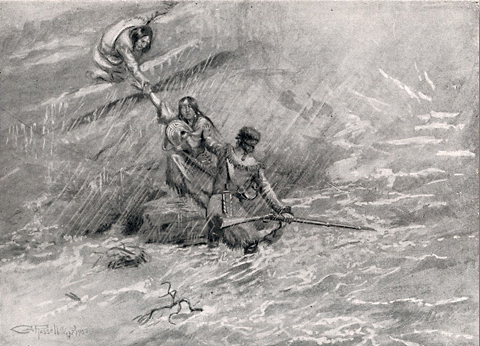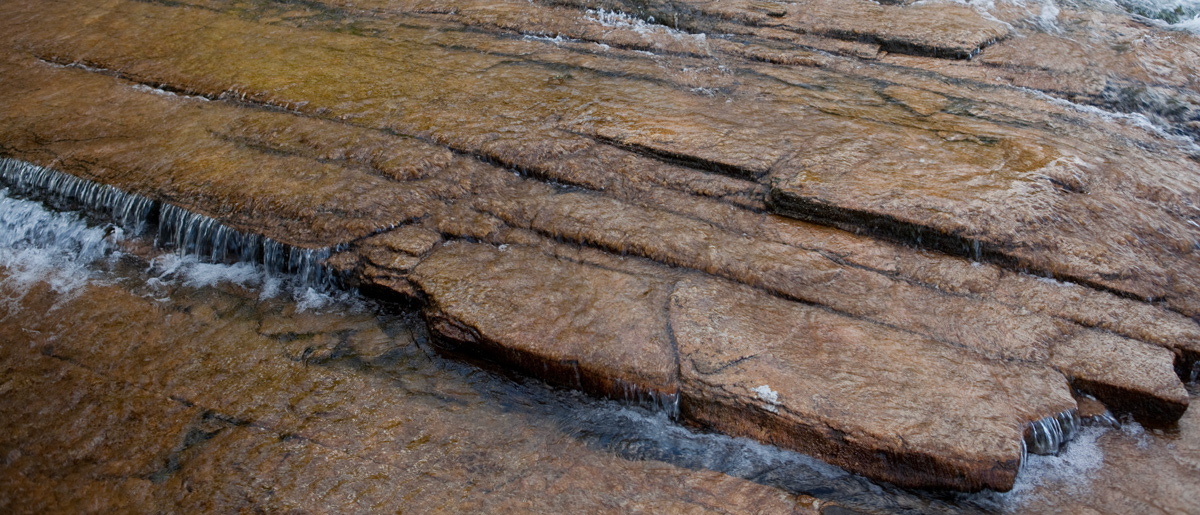Along the portage around the Great Falls of the Missouri, hail and rain disrupt the day’s work. Baggage is left on the plain, men are bruised and bloody, and Sacagawea and her baby Jean Baptiste are nearly swept away in a flash flood. Clark’s group remains at Box Elder Creek unable to cross its swollen waters.
Fountain and Flash Flood
by Yellowstone Public Radio[1]Originally aired weekdays by Yellowstone Public Radio during the Bicentennial observance of 2003-2006. Narrated by Hal Hansen. Scripts by Whit Hansen and Ed Jacobson. Produced by Leni Holliman. © … Continue reading
Breathless Moment
C.M. Russell (1903), for Olin D. Wheeler, The Trail of Lewis and Clark. See also Wheeler’s “Trail of Lewis and Clark”.
Flash Flood
the rain fell like one voley of water falling from the heavens and gave us time only to get out of the way of a torrent of water which was Poreing down the hill in the rivin with emence force tareing every thing before it takeing with it large rocks & mud, I took my gun & Shot pouch in my left hand, and with the right Scrambled up the hill pushing the Interpreters wife [Sacagawea] (who had her Child [Jean Baptiste] in her arms) before me, the Interpreter himself [Toussaint Charbonneau] makeing attempts to pull up his wife by the hand much Scared and nearly without motion— we at length retched the top of the hill Safe where I found my Servent [York] in Serch of us greatly agitated, for our wellfar—
—William Clark
Items Washed Away
I lost at the river in the torrent the large Compas, an eligant fusee [a trade guns], Tomahawk Humbrallo [Clark’s Umbrella], Shot pouh, & horn wih powder & Ball, mockersons, & the woman lost her Childs Bear [mosquito netting] & Clothes bedding &c.— The Compass is a Serious loss; as we have no other large one.
—William Clark
Bloody Hail
I went with the p[arty] for the remainder of the baggage. we got all and was returning. Saw a black cloud rise in the west which we looked for emediate rain we made all the haste possable but had not got half way before the Shower met us and our hind extletree broke in too we were obledged to leave the load Standing and ran in great confusion to Camp the hail being So large and the wind So high and violent in the plains, and we being naked we were much bruuzed by the large hail. Some nearly killed one knocked down three times, and others without hats or any thing about their heads bleading and complained verry much.
—John Ordway
Giant Springs
© 30 June 2013 by Kristopher K. Townsend. Permission to use granted under the Creative Commons Attribution-Share Alike 4.0 International license.
Giant Springs
not having seen the large fountain [Giant Springs] of which Capt. Clark spoke I determined to visit it today as I could better spare this day from my attention to the boat [iron-framed boat] . . . . I think this fountain the largest I ever beheld, and the hadsome cascade which it affords over some steep and irregular rocks in it’s passage to the river adds not a little to it’s beauty.
—Meriwether Lewis
Weather Diary
State of the thermometer at rise
Weather Wind at rise
State of the thermometer at 4 OC. P.M. Weather Wind at 4 OC. P. M. State of river 47 [above 0] rain, thunder, & lightning S. W. 77 [above 0] fair S. W. raised 4 ½ in. heavy gust of rain the morning and evening
—Meriwether Lewis[2]To assist the reader, the editor of this web page has omitted the date column, merged the “State of the river” columns, and spelled out some abbreviations.
The Great Falls Portage is a High Potential Historic Site along the Lewis and Clark National Historic Trail managed by the U.S. National Park Service. It includes Sulpher Spring (open to the public) and Lower Portage Camp site (private land), and the Upper Portage Camp Overlook.
Giant Springs is a High Potential Historic Site along the Lewis and Clark National Historic Trail managed by the U.S. National Park Service. The site is a Montana State Park just downstream of the Lewis and Clark Interpretive Center (USFS).
Notes
| ↑1 | Originally aired weekdays by Yellowstone Public Radio during the Bicentennial observance of 2003-2006. Narrated by Hal Hansen. Scripts by Whit Hansen and Ed Jacobson. Produced by Leni Holliman. © 2003 by Yellowstone Public Radio. |
|---|---|
| ↑2 | To assist the reader, the editor of this web page has omitted the date column, merged the “State of the river” columns, and spelled out some abbreviations. |




